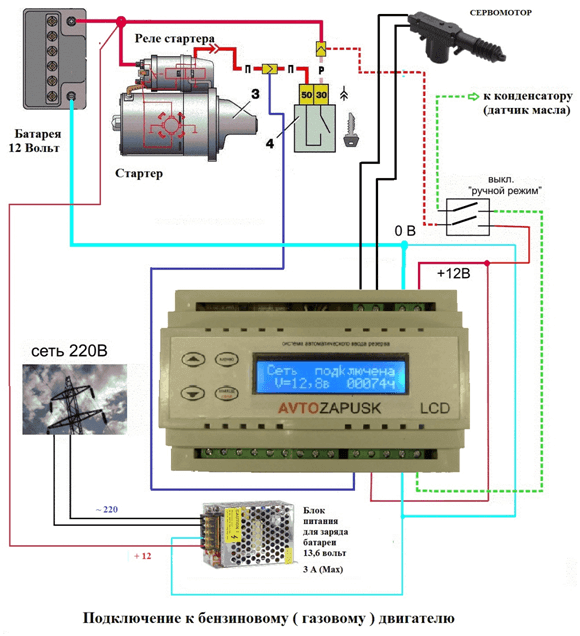Why do I need an automatic reserve input and how does the automatic transfer switch work?
Appointment ABP
The purpose of this system in an electrician is similar to the organization of uninterrupted power. The main task of automatic input of backup power is a quick restoration of power supply without the participation of a person in this process. In large substations, there are always two inputs into two, separated by a sectional switch, sections of the switchgear operating independently from each other. According to PUE (rules for the installation of electrical installations) automatic connection of backup power and supply for 2 inputs is a mandatory measure to provide electricity to consumers of the first category.
A simple example of the need for this system can be given regarding the lighting of some important protected area. That is, when the main input is turned off, the system itself will turn on the power from the backup source, while this important area will remain lit. The maximum that can occur is a short cessation of nutrition, which is even difficult to visually track. It depends on the speed of operation of the ATS, the time for switching on the reserve should be about 0.3-0.8 seconds.
How automatic backup power input works
The principle of operation of the ATS is based on monitoring the voltage in the circuit. This can be done using any voltage relay or digital logic protection blocks. However, the principle of work all early remains unchanged. Let's consider it on the simplest example.
This is a single-line diagram, which shows that voltage is monitored contactor KM. Both machines QS1 and QS2 must be turned on, while the coil KM will receive power and will be retracted, and accordingly, its make contact in the main input circuit is also closed and the make contact in the backup input circuit is open.Thus, the power supply to the consumer is carried out from the main network and the corresponding lamps are lit. In the event of a power failure on the L12 line and a voltage drop to the value when the KM contactor is disconnected, the make contact will open in the main line and at the same time the contact in the backup power supply line L22 will go into closed state, thereby supplying voltage to the consumer from the backup source . The reverse situation will occur when renewing the main power supply via line L12.
In the video below, the principle of operation of the ATS in 6 kV networks is clearly considered:
System requirements
The main requirements for ATS systems are:
- Performance.
- Reliability of inclusion.
- Supply voltage only if there is no short circuit, that is, there must be a lock in the short circuit.
- Single actuation.
- The ability to configure the threshold for turning on the backup power supply so that it does not work, for example, during voltage drops during the start-up of powerful electric motors.
- Triggering is only provided that there is electricity at the backup input.
Naturally, the simplest circuit on the contactors will not be able to realize all the requirements for the ATS system. To do this, modern electronics use logic systems that signal the inclusion of a backup power source only if all the rules and interlocks are observed. Also, for added reliability, mechanical locking is even used.
ABP classification and implementation options
Backup power can be provided and its automatic input can be from a separate generator, battery or a separate line.
In turn, all ATS systems by their action are divided into:
- One sided. One section or input is working (main), and the second is reserve. In case of disappearance of the operating voltage, the reserve is switched on.
- Bilateral. When there are two separately powered sections and, accordingly, two lines are working, and when one of them is disconnected, the other is a backup.
Also, the ATS can be with power recovery according to the normal scheme and without it. In the second case, the non-working network is completely extinguished and even when the power is restored again, the circuit will not work as before on two lines.
Features of working with household generators
In order to organize the automatic input of the reserve in the house, you can use an autonomous generator as a backup power source. It will provide an opportunity for a long time to provide electrical energy to the whole house, and the magnitude of the connected load depends on the power of the generator itself. Here is the connection diagram:
The introduction of a generator as a source of electricity instead of mains voltage can be practiced in a single-phase and three-phase network, taking into account the model of the generator. However, in order for this process to be fully automated, it is necessary that the generator is equipped with a starter, and you will also need a special unit consisting of a set of switching devices that turn on the starter only for the duration of the start and disconnect when the mains voltage is restored. It looks like this:
Such a block for the generator is compatible with any type of engine and has three positions: “Stop”, “On,” “Start”. True, in winter, the internal combustion engine needs to be warmed up, but this unit can be programmed, taking into account this feature. It is mounted on din rail in the switchboard.
The video clearly explains the scheme by which you can make an automatic reserve input for the generator with your own hands:
ATS on batteries
With the development of converters that transform direct current into alternating current, it becomes possible to use, for example, a car battery as a backup power source.In addition to the battery, you will need to purchase a modern car inverter that converts 12 volts DC to 220 volts AC.
True, this source can hardly be used for power loading, but it can easily provide a lighting circuit with stable voltage during a short accident on the line. At the same time, the duration of the operation will depend on the power of consumers and the capacity of the batteries.
To increase capacity, you can connect several batteries in parallel. The connection scheme of the ABP system itself can be implemented using starter.
The starter is included in the main circuit, and in case of network problems, its moving part disappears, thereby its opening block contact, introduced into the battery circuit, starts the automatic power supply system. This method is less expensive than the generator, but is not able to produce a long time current for powerful household appliances.
Logic Controller Application
For two three-phase power supply networks, ready-made ATS units are used using a logical digital controller that can take into account many parameters required to create an ideal system. It has all the necessary markings and instructions for managing and connecting.
However, before you connect the module and purchase it, you need to think about whether there is a backup power source with a more reliable power supply. Since it makes no sense to connect it to the same system of a three-phase network, that is, powered by a single transformer 6 / 0.4 kV.
Organization of ABP in high voltage circuits
In order to organize automatic backup in circuits with a voltage of more than 1000 Volts, a special voltage transformer is used as an element measuring and controlling the network energy, on the secondary winding of which 100 Volt is in normal operation. To connect it with the ABP system, a minimum voltage relay is used or phase control relay. It reacts not only to a decrease in the mains voltage, but also to the disappearance of at least one phase, for example, when the overhead line is broken. Here, it is already necessary to fulfill all the requirements regarding the correct entry of the automatic transfer switch, and sometimes even with a system with recovery, a time delay is set to return to the original initial configuration.
It is also important to note that in high-voltage networks, the ABP automation circuitry is implemented on old-style electromechanical relays or modern multifunctional microprocessor protection terminals that perform several functions, including ABP.
Finally, we recommend watching a useful video on the topic of the article:
Now you know what automatic reserve input is, what are the ATS schemes and what is the principle of operation of this power supply system. We hope the provided information and video tutorials were useful to you!
Surely you do not know:











